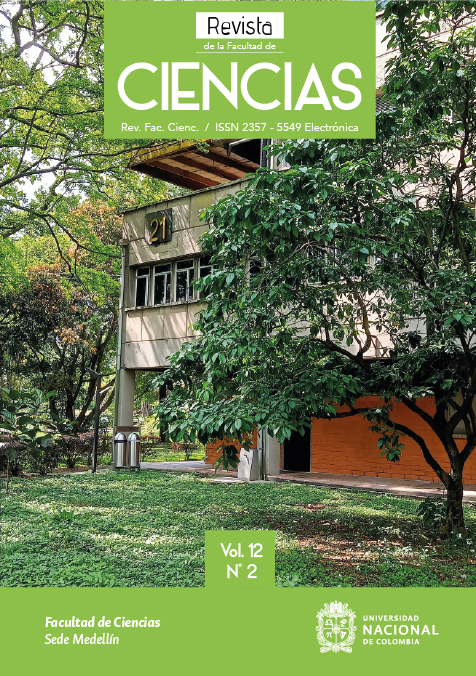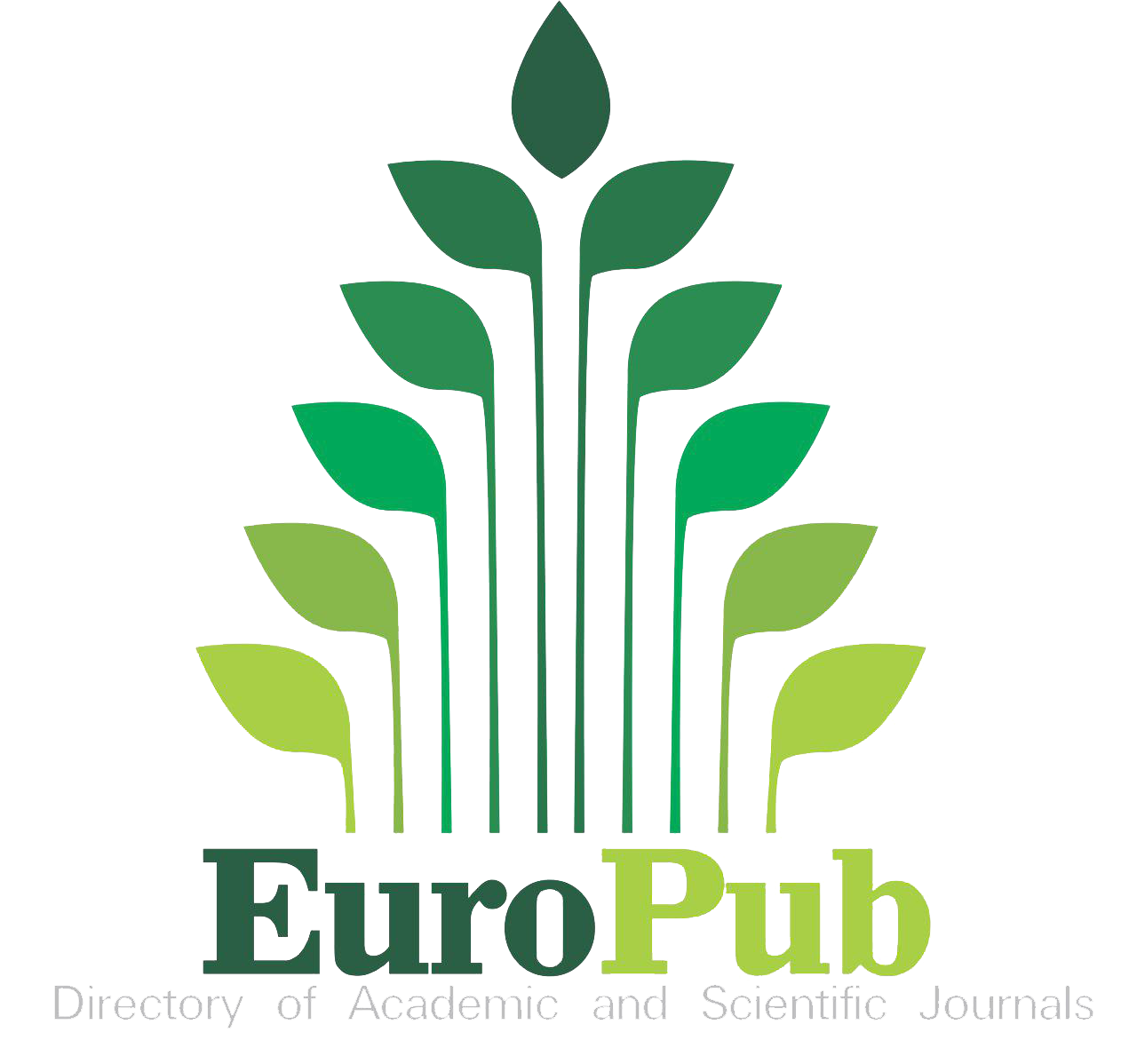OPTO-ELECTRONICS AND NONLINEAR OPTICAL PROPERTIES OF ISOINDOLINE-1,3-DIONE-FULLERENE20-ISOINDOLINE-1,3-DIONE USING DENSITY FUNCTIONAL THEORY
OPTO-ELECTRÓNICA Y PROPIEDADES ÓPTICAS NO LINEALES DE ISOINDOLINA-1,3-DIONA-FULLERENO20-ISOINDOLINA-1,3-DIONA UTILIZANDO LA TEORÍA FUNCIONAL DE LA DENSIDAD
DOI:
https://doi.org/10.15446/rev.fac.cienc.v12n2.107224Palabras clave:
NLO properties, A-D-A, Fullerene, Intramolecular charge transfer, Torsional angles (en)Propiedades NLO, A-D-A, Fullereno, transferencia de carga intramolecular, ángulos de torsión (es)
Descargas
Linear and nonlinear properties of isoindoline-1,3-dione-fullerene-isoindoline-1,3-dione with the five phases were studied. The geometries of the isoindoline-1,3-dione-fullerene-isoindoline-1,3-dione combination were attained using density functional theory DFT/B3LYP/6-31G+(d,p). The calculated properties are static polarizability, anisotropy of polarizability and first static hyperpolarizability at equilibrium geometry. In this article, the theoretical design of NLO molecules is discussed. The results show that there is a good electronic transfer within this molecule, and have a reasonably good propensity for nonlinear optical activity.
Se estudiaron las propiedades lineales y no lineales de isoindolina-1,3-diona-fullereno-isoindolina-1,3-diona con las cinco fases. Las geometrías de la combinación de isoindolina-1,3-diona-fullereno-isoindolina-1,3-diona se obtuvieron utilizando la teoría funcional de la densidad DFT/B3LYP/6-31G+(d,p). Las propiedades calculadas son la polarizabilidad estática, la anisotropía de la polarizabilidad y la primera hiperpolarizabilidad estática en la geometría de equilibrio. En este artículo, se discuten los resultados del diseño teórico de moléculas NLO. Los resultados muestran que existe una buena transferencia electrónica dentro de esta molécula y tienen una propensión razonablemente buena a la actividad óptica no lineal.
Referencias
Alyar, H., M. Bahat, ERGÜN Kasap & Z. Kantarci (2006). Torsional Barriers and Nonlinear Optical Properties of 2-, 3-, 4-Phenylpyridine Molecules. Czechoslovak Journal of Physics 56 (4), 349–358. https://doi.org/10.1007/s10582-006-0096-4. DOI: https://doi.org/10.1007/s10582-006-0096-4
Bahat, Mehmet & Emre Yörük (2009). A Computational Study on Structural, Electronic and Nonlinear Optical Properties of Furylpyridine Molecules. Proceedings of the 9th WSEAS International Conference on Applied Computer Science, 40–44.
Bahrani, F., Hameed, R., Resan S. & Al-anber, M. (2022). Impact of Torsion Angles to Tune Efficient Dye-Sensitized Solar Cell/Donor-π-Acceptor Model Containing Triphenylamine: DFT/TD-DFT Study. Acta Physica Polonica A 141 (6), 561–568. https://doi.org/10.12693/APhysPolA.141.561. DOI: https://doi.org/10.12693/APhysPolA.141.561
Dennington, Roy, Todd Keith & John Millam (2009). Semichem Inc. Shawnee Mission KS, GaussView, Version 5 (8).
Dikomang, Kago (2019). Elucidation of Structure− Property Correlations Using Experimental Nuclear Magnetic Resonance (NMR) and Fourier Transform Infrared (FTIR) Specroscopy Analysis, and Density Functional Theory (DFT) Calculations of the Difurylmethane (DFM) Molecule, and difurylmethane-methanol clusters.
Frisch, M J, G W Trucks, H B Schlegel, G E Scuseria, M A Robb, J R Cheeseman, G Scalmani, V Barone, B Mennucci & GAea Petersson. (2009). Gaussian 09, Revision A.02, Gaussian, Inc., Wallingford CT. See Also: URL: http://www. Gaussian. com.
Günay, N, Ö Tamer, D Avci, E Tarcan & Y Atalay (2020). Molecular Modelling, Spectroscopic Characterization and Nonlinear Optical Analysis on N-Acetyl-DL-Methionine. Revista Mexicana de Física, 66 (6), 749–760. DOI: https://doi.org/10.31349/RevMexFis.66.749
Hashemi, Daniel, Xiao Ma, Ramin Ansari, Jinsang Kim & John Kieffer (2019). Design Principles for the Energy Level Tuning in Donor/Acceptor Conjugated Polymers. Physical Chemistry Chemical Physics, 21 (2), 789–799. https://doi.org/10.1039/c8cp03341b. DOI: https://doi.org/10.1039/C8CP03341B
Janjua, Muhammad Ramzan Saeed Ashraf (2017). Nonlinear Optical Response of a Series of Small Molecules: Quantum Modification of π-Spacer and Acceptor. Journal of the Iranian Chemical Society, 14 (9), 2041–2054. https://doi.org/10.1007/s13738-017-1141-x. DOI: https://doi.org/10.1007/s13738-017-1141-x
Kadadevarmath, J S, G H Malimath, N R Patil, H S Geethanjali & R M Melavanki (2013). Solvent Effect on the Dipole Moments and Photo Physical Behaviour of 2, 5-Di-(5-Tert-Butyl-2-Benzoxazolyl) Thiophene Dye. Canadian Journal of Physics, 91 (12), 1107–1113. DOI: https://doi.org/10.1139/cjp-2013-0195
Kadhim, Mustafa M, Taleeb Zedan Taban, Sallal A H Abdullaha, Zainab Sabri Abbas, Safa K Hachim, Ahmed Mahdi Rheima, Haider Abdulkareem Almashhadani & Abdol Ghaffar Ebadi (2022). Design New D-π-A Materials for Sensitizers for Dye-Sensitized Solar Cells: Quantum Chemical Study. Optik, 270,169863. DOI: https://doi.org/10.1016/j.ijleo.2022.169863
Khalid, Muhammad, Riaz Hussain, Ajaz Hussain, Bakhat Ali, Farrukh Jaleel, Muhammad Imran, Mohammed Ali Assiri, et al. (2019). Electron Donor and Acceptor Influence on the Nonlinear Optical Response of Diacetylene-Functionalized Organic Materials (DFOMs): Density Functional Theory Calculations. Molecules 24 (11), https://doi.org/10.3390/molecules24112096. DOI: https://doi.org/10.3390/molecules24112096
Khalid, Muhammad, Mashal Khan, Iqra Shafiq, Khalid Mahmood, Muhammad Nadeem Akhtar, Javed Iqbal, Mohammed A Assiri, Muhammad Imran & Ataualpa Albert Carmo Braga (2023). Role of Donors in Triggering Second Order Non-Linear Optical Properties of Non-Fullerene FCO-2FR1 Based Derivatives: A Theoretical Perspective. Heliyon, 9 (2), e13033. DOI: https://doi.org/10.1016/j.heliyon.2023.e13033
Khalid, M., Zafar, M., Hussain, S., Asghar, M. A., Khera, R. A., Imran, M., Abookleesh, F. L., Akram, M. Y., & Ullah, A. (2022). Influence of End-Capped Modifications in the Nonlinear Optical Amplitude of Nonfullerene-Based Chromophores with a D-π-A Architecture: A DFT/TDDFT Study. ACS omega, 7(27), 23532–23548. https://doi.org/10.1021/acsomega.2c02052 DOI: https://doi.org/10.1021/acsomega.2c02052
Kiven, Dinyuy Emmanuel, Nyiang Kennet Nkungli, Stanley Numbonui Tasheh & Julius Numbonui Ghogomu (2023). In Silico Screening of Ethyl 4-[(E)-(2-Hydroxy-4-Methoxyphenyl)Methyleneamino]Benzoate and Some of Its Derivatives for Their NLO Activities Using DFT. Royal Society Open Science, 10 (1). https://doi.org/10.1098/rsos.220430. DOI: https://doi.org/10.1098/rsos.220430
Labidi, Nouar Sofiane (2016). Semi Empirical and Ab Initio Methods for Calculation of Polarizability (α) and the Hyperpolarizability (β) of Substituted Polyacetylene Chain. Arabian Journal of Chemistry 9, S1252–S1259. https://doi.org/10.1016/j.arabjc.2012.01.007. DOI: https://doi.org/10.1016/j.arabjc.2012.01.007
Mbala, G. F.Olinga, C. D.D. Mveme, Z. Ntieche, G. W. Ejuh, J. M.B. Ndjaka & M. T.Ottou Abe (2021). Effect of Chlorine and Bromine on the Nonlinear Optical, Electronic, Optoelectronic and Thermodynamic Properties on the BEDT-TTF Molecule: Ab-Initio and DFT Calculations. Optical and Quantum Electronics 53 (10), 1–18. https://doi.org/10.1007/s11082-021-03211-4. DOI: https://doi.org/10.1007/s11082-021-03211-4
Migalska-Zalas, A, · K El Korchi & T Chtouki (2018). Enhanced Nonlinear Optical Properties Due to Electronic Delocalization in Conjugated Benzodifuran Derivatives. Optical and Quantum Electronics 50, 389. https://doi.org/10.1007/s11082-018-1659-x. DOI: https://doi.org/10.1007/s11082-018-1659-x
Parol, Vinay, A. N. Prabhu, Md Abu Taher, Sri Ram G. Naraharisetty, N. K. Lokanath & V. Upadhyaya (2020). A Third-Order Nonlinear Optical Single Crystal of 3,4-Dimethoxy-Substituted Chalcone Derivative with High Laser Damage Threshold Value: A Potential Material for Optical Power Limiting. Journal of Materials Science: Materials in Electronics 31 (12). https://doi.org/10.1007/s10854-020-03443-2. DOI: https://doi.org/10.1007/s10854-020-03443-2
Resan, S., R. Hameed, A. Al-Hilo & M. Al-Anber (2020). The Impact of Torsional Angles to Tune the Nonlinear Optical Response of Chalcone Molecule: Quantum Computational Study. Revista Cubana de Fisica 37 (2), 95–100.
Shettigar, Venkataraya, P S Patil, S Naveen, S M Dharmaprakash, M A Sridhar & J Shashidhara Prasad (2006). Crystal Growth and Characterization of New Nonlinear Optical Chalcone Derivative: 1-(4-Methoxyphenyl)-3-(3, 4-Dimethoxyphenyl)-2-Propen-1-One. Journal of Crystal Growth, 295 (1), 44–49. DOI: https://doi.org/10.1016/j.jcrysgro.2006.06.047
Shkir, Mohd., S Omar, M Aslam Manthremmel, M. A. Khan & Ahmad Umar (2022). DFT Studies on a Novel 1-Ethyl-4-Phenyl-1,5-Benzodiazepin-2-Thione Molecule and Its Derivatives for Opto-Nonlinear Applications. Engineered Science. https://doi.org/10.30919/es8d714. DOI: https://doi.org/10.30919/es8d714
Soscún, Humberto, Olga Castellano, Yaneth Bermúdez, Carlos Toro-Mendoza, Arı́stides Marcano & Ysaı́as Alvarado (2002). Linear and Nonlinear Optical Properties of Pyridine N-Oxide Molecule. Journal of Molecular Structure: THEOCHEM, 592 (1), 19–28. https://doi.org/https://doi.org/10.1016/S0166-1280(02)00222-1. DOI: https://doi.org/10.1016/S0166-1280(02)00222-1
Wagnière, G. (1986). Theoretical Investigation of Kleinman Symmetry in Molecules. Applied Physics B Photophysics and Laser Chemistry, 41 (3), 169–172. https://doi.org/10.1007/BF00693918. DOI: https://doi.org/10.1007/BF00693918
Wazzan, Nuha A, Ohoud S Al-Qurashi & Hassan M Faidallah (2016). DFT/and TD-DFT/PCM Calculations of Molecular Structure, Spectroscopic Characterization, NLO and NBO Analyses of 4-(4-Chlorophenyl) and 4-[4-(Dimethylamino) Phenyl]-2-Oxo-1, 2, 5, 6-Tetrahydrobenzo [h] Quinoline-3-Carbonitrile Dyes. Journal of Molecular Liquids, 223, 29–47. DOI: https://doi.org/10.1016/j.molliq.2016.07.146
Yang, Zhenqing, Chunmeng Liu, Changjin Shao, Xiaofei Zeng, Dapeng Cao, and D. Screening Yang, Z.; Liu, C.; Shao, C.; Zeng, X.; Cao (2016). Screening π-Conjugated Bridges of Organic Dyes for Dye-Sensitized Solar Cells with Panchromatic Visible Light Harvesting. Nanotechnology, 27 (26), 265701. https://doi.org/10.1088/0957-4484/27/26/265701. DOI: https://doi.org/10.1088/0957-4484/27/26/265701
Ye, Jin Ting, Xing Yi Chen & Yong Qing Qiu (2022). First Hyperpolarizabilities of Intramolecular Charge-Transfer Architectures Based on Acenaphthene Derivatives in Gas, Solution, and Solid States. Journal of Physical Chemistry A 126 (41), 7432–7441. https://doi.org/10.1021/acs.jpca.2c04380. DOI: https://doi.org/10.1021/acs.jpca.2c04380
Cómo citar
APA
ACM
ACS
ABNT
Chicago
Harvard
IEEE
MLA
Turabian
Vancouver
Descargar cita
Licencia
Derechos de autor 2023 Revista de la Facultad de Ciencias

Esta obra está bajo una licencia internacional Creative Commons Atribución-NoComercial-SinDerivadas 4.0.
Los autores o titulares del derecho de autor de cada artículo confieren a la Revista de la Facultad de Ciencias de la Universidad Nacional de Colombia una autorización no exclusiva, limitada y gratuita sobre el artículo que una vez evaluado y aprobado se envía para su posterior publicación ajustándose a las siguientes características:
1. Se remite la versión corregida de acuerdo con las sugerencias de los evaluadores y se aclara que el artículo mencionado se trata de un documento inédito sobre el que se tienen los derechos que se autorizan y se asume total responsabilidad por el contenido de su obra ante la Revista de la Facultad de Ciencias, la Universidad Nacional de Colombia y ante terceros.
2. La autorización conferida a la revista estará vigente a partir de la fecha en que se incluye en el volumen y número respectivo de la Revista de la Facultad de Ciencias en el Sistema Open Journal Systems y en la página principal de la revista (https://revistas.unal.edu.co/index.php/rfc/index), así como en las diferentes bases e índices de datos en que se encuentra indexada la publicación.
3. Los autores autorizan a la Revista de la Facultad de Ciencias de la Universidad Nacional de Colombia para publicar el documento en el formato en que sea requerido (impreso, digital, electrónico o cualquier otro conocido o por conocer) y autorizan a la Revista de la Facultad de Ciencias para incluir la obra en los índices y buscadores que estimen necesarios para promover su difusión.
4. Los autores aceptan que la autorización se hace a título gratuito, por lo tanto renuncian a recibir emolumento alguno por la publicación, distribución, comunicación pública y cualquier otro uso que se haga en los términos de la presente autorización.
5. Todos los contenidos de la Revista de la Facultad de Ciencias, están publicados bajo la Licencia Creative Commons Atribución – No comercial – Sin Derivar 4.0.
MODELO DE CARTA DE PRESENTACIÓN y CESIÓN DE DERECHOS DE AUTOR






















